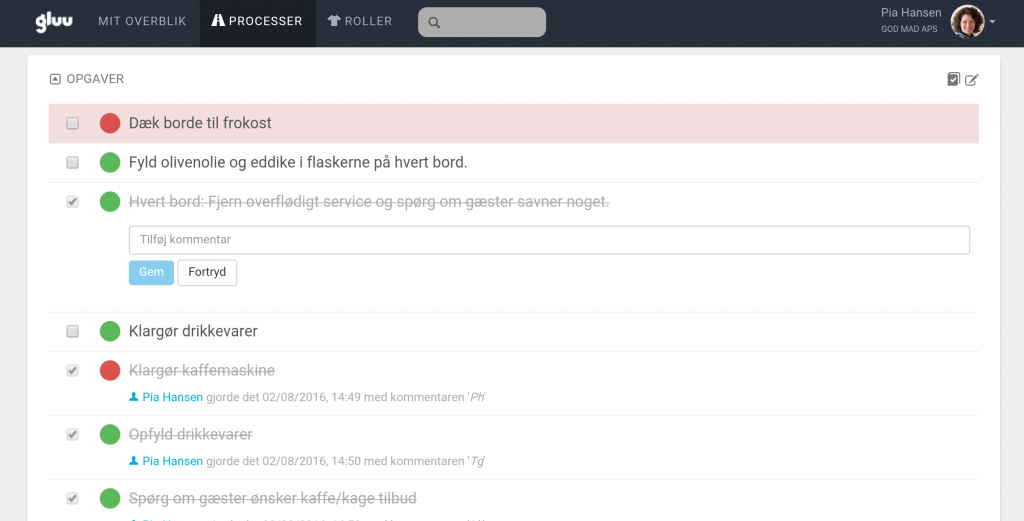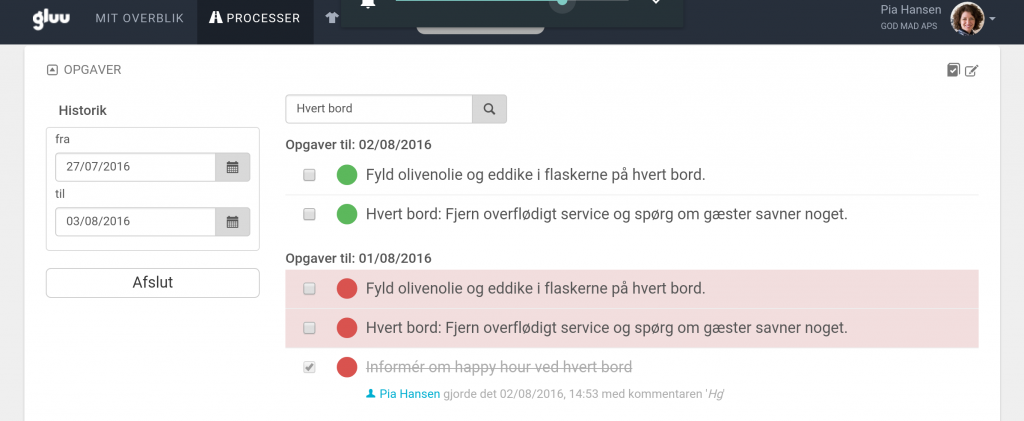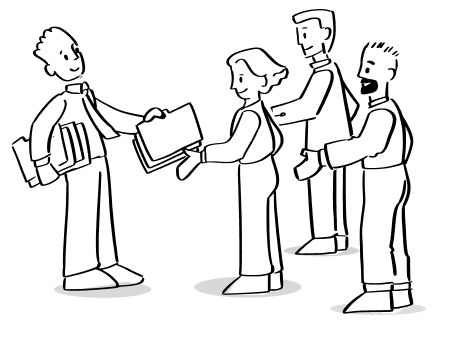
How the café service got better

Here is the story of a Danish café that tightened up the café service in everyday life and improved both the guests’ experience and sales. Read it as inspiration on how you could do the same. It’s about better follow-up on the little things in everyday life that make the difference.
The story is based on a real Copenhagen café. The café is part of a small chain and would rather not come forward by name, because as the owner puts it: “We don’t want to air our dirty underwear”. We therefore call the café “MadGlad”, and all names below are fictitious.
MadGlad – a typical Copenhagen café
From a location fairly central in Copenhagen, MadGlad offers morning coffee, lunch and dinner seven days a week. The staff consists of three permanent employees. In addition, there are approximately 15 students working between 8 and 20 hours a week. The owner, we could call him Michael Smith, even manages all his cafes.
Checklists not looked at
MadGlad has long had four checklists for daily operations: “Open list”, “Closing list”, “Self-monitoring” and “Kitchen”. They are all laminated and hang on the wall at each workstation. Employees are supposed to see what needs to be done so that it is remembered every time. Otherwise, everything is “handheld” by Michael and his three permanent employees.
MadGlad’s cafes have decent earnings. However, it could get better. Michael sees an increase in sales on the days when he is at work serving his guests. His part-time employees rarely reach the same level. That difference must be eliminated.
The bad review
Over the past six months, turnover has unfortunately gone downhill. It started with a bad review in a newspaper. The reviewer had received poor and disinterested café service from the staff at MadGlad. From here, a minor shitstorm on Facebook began. Now MadGlad has a semi-bad reputation among the residents of the area.
After the review came out, Michael spoke dunder to everyone. The speech made the café service a little better for a while. Slowly, however, everything fell back to normal. The problem is that when Michael is not present in person, he never knows if every task on the checklists will be completed correctly and on time. He also has the feeling that only the brand new employees look at the checklists. The rest of the employees only do what is absolutely necessary. When he confronts an employee with a defect, it has always only happened once. However, Michael doesn’t quite believe this to be the case.
Michael will follow up more closely
One day, Michael is visited by Till from Gluu. Till shows how Michael can easily create all MadGlad’s tasks and ensure that each task is presented to the right employee at the right time. After this, the employee automatically reports back when it is completed. In this way, Michael can ensure a much closer follow-up when he is not present physically.
Michael decides to try Gluu. Mostly to focus on customer service. Till gives him a starter guide that he can use.
Now he will first create the “Open” and “Close Lists” so that he can automate them. It happens in minutes…
- First, Michael Gluu’s built-in roles for “Waiter” and “Bar” are corrected to suit GodMad.
- Then he creates each task in MadGlad’s “Open” and “Close list” and the time the task should happen. Then the minimum level is in place and the old lists can be taken down.
- He then adds three daily tasks, which are about actively operating the tables. The goal is that tables are cleared regularly and that guests can order more without having to get up. It’s only something that staff have time for at certain times:

Try Gluu for free
Sign up for a 30-day trial.
No credit card required.
Employees are instructed
After Michael has made up his take on everything to remember, he calls the employees together at their regular meeting every Friday morning. Here he shows them his daughter’s old iPad, which has now been given a permanent place in the bar. Here the Gluu app is installed.
When employees log in as “Waiter” or “Bar”, they only see the tasks that need to be done at certain times. If the assignment is to take place between 2 pm and 4 pm, it will be shown at 2 pm. After this, it gradually turns more and more red before it is exceeded at 4 pm. There are many tasks in the system, but each employee only has to deal with what needs to happen right now.
Michael says that the close follow-up will ensure that guests get a better experience. It is his responsibility that the proper tasks are inside Gluu, but it is the responsibility of each employee to complete them on time. There are after-work drinks at Michael’s expense the first time, all tasks are completed on time over two weeks.
First day with Gluu
Pia opens the café on Monday morning. The first thing she does is open the Gluu app. Here she now sees the opening list. She routinely completes the tasks and presses to mark each as completed – each time with her initials and a small comment, if there is something special that needs to be remembered, for example.

At 10 am, Sheela arrives at work. She selects “Weekly list for waiters” and sees the new tasks with table service. At 12 noon, she goes for a round, cleans up and asks if guests want to have lunch. Several of the guests are pleasantly surprised by the active service. “It’s almost like being south again,” as one of them puts it. Sheela writes what she sold in the commentary on the assignment.
After 14 days, the status is taken
The next morning, there is an email in Michael’s inbox. Here he can see that the great service of the coffee machine was not carried out on Monday morning as he had otherwise intended. He makes a comment to Sheela. She obviously didn’t know how to solve the task. Michael now posts a YouTube video on the page under work instructions. Now everyone can easily see how a service is implemented.
Every morning, Michael calls the responsible employee if something is forgotten. The first time is ok but the second time is sloppy.
That’s how 14 days pass. At the weekly Friday meeting, Michael takes stock of the café’s service. He shows the list of tasks that were forgotten over the past week. They talk about why it happened and together add a number of new tasks.

The result: Better service and higher sales
Michael searches for the new tasks within café service and can quickly calculate the additional sales.
Michael’s calculation:
Each round to MadGlad’s 30 tables has led to the sale of an average of four extra cups of coffee, water or beer. With three rounds a day, seven days a week, 84 extra drinks a week or 168 have been sold over the entire period. Something had been sold without the close service, so Michael deducts 20%. He finds that in just one hour of preparation, he has increased sales by 134 drinks per month. With an average price of DKK 30, that’s DKK 4,000 in extra revenue per month per café. Gluu costs DKK 299 per month and paid for itself on the first three days of the month.
What was intended as an improvement in café service now contributed directly to the bottom line. Imagine what it can become when he gets new ideas that he will quickly try out and maybe turn into everyday life!
Conclusion
In conclusion, the cafe service industry has significantly improved due to the integration of modern technology and effective management strategies. These advancements led to the optimization of operations, better customer service, and increased profitability. Constant modifications and adaptation to modern trends have also played a huge role in reshaping cafe services, enhancing efficiency, and ensuring customer satisfaction. By utilizing resources such as workforce management software and customer feedback systems, cafes have been able to streamline their services to enhance customer experiences. Thus, the cafe service landscape has evolved considerably and will continue to flourish in tune with technological advancements and changing customer expectations.

Try Gluu for free
Sign up for a 30-day trial.
No credit card required.
Frequently Asked Questions
To enhance the employee training program in cafes, a few specific measures have been taken. Firstly, a comprehensive and well-structured training curriculum has been developed, providing employees with detailed knowledge in all areas of cafe operation. Secondly, frequent workshops and seminars are held for more applied, hands-on learning. Both these measures are supplemented with regular assessments to measure learning outcomes.
Yes, there have been noticeable customer responses with the improvement of cafe service. Customers have noted a marked increase in the quality of service, particularly in terms of promptness and attention to detail. Additionally, they’ve commented positively on the enhanced knowledge of the cafe staff about the various offerings, which has helped them make more informed choices.
We collect customer feedback through multiple channels. At the forefront is a feedback form provided to all customers post their cafe visit. In addition, we also have an online form available on our website. Lastly, we encourage our employees to engage with guests and collect verbal feedback. This feedback is then analyzed and incorporated into our continuous improvement process. It helps us identify gaps, come up with actionable recommendations, and subsequently enhance the cafe service.
About the Author









